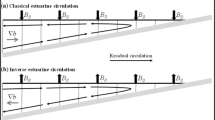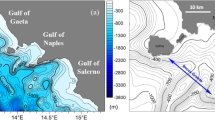Abstract
A high-resolution (∼1 km horizontal grid and 21 vertical layers) numerical model based on the Princeton Ocean Model (POM) has been used to study the 3D dynamics of the Upper Gulf of Thailand (UGOT). While influenced by tides and rivers like other estuarine systems, the UGOT is unique because it is wide (∼100 km × 100 km), it is shallow (average depth of only ∼15 m), it is located in low latitudes (∼12.5°N–13.5°N), and it is influenced by the seasonal monsoon. Sensitivity studies were thus conducted to evaluate the impact that surface heat fluxes, monsoonal winds, river runoffs, and the low latitude may have on the dynamics; the latter has been evaluated by modifying the Coriolis parameter and comparing simulations representing low and mid latitudes. The circulation in the UGOT changes seasonally from counter-clockwise during the northeast monsoon (dry season) to clockwise during the southwest monsoon (wet season). River discharges generate coastal jets, whereas river plumes tend to be more symmetric near the river mouth and remain closer to the coast in low latitudes, compared with mid-latitude simulations. River plumes are also dispersed along the coast in different directions during different stages of the monsoonal winds. The model results are compared favorably with a simple wind-driven analytical estuarine model. Comparisons between an El Niño year (1998) and a La Niña year (2000) suggest that water temperatures, warmer by as much as 2 °C in 1998 relative to 2000, are largely driven by decrease cloudiness during the El Niño year. The developed model of the UGOT could be used in the future to address various environmental problems affecting the region.











Similar content being viewed by others
References
Albretsen J, Røed LP (2010) Decadal long simulations of mesoscale structures in the northern North Sea/Skagerrak using two ocean models. Ocean Dyn 60(4):933–955. doi:10.1007/s10236-010-0296-0
Blumberg, AF, Mellor, GL (1987) A description of a three-dimensional coastal ocean circulation model. In: N. Heaps (ed.) Three-dimensional coastal ocean models. American Geophysical Union, 208pp
Buranapratheprat A, Yanagi T, Matsumura S (2008a) Seasonal variation in water column conditions in the upper Gulf of Thailand. Cont Shelf Res 28:2509–2522
Buranapratheprat A, Yanagi T, Niemann KO, Matsumura S, Sojisuporn P (2008b) Surface chlorophyll-a dynamics in the upper Gulf of Thailand revealed by a coupled hydrodynamics ecosystem model. J Oceanogr 64:639–656
Buranapratheprat A, Niemann KO, Yanagi T, Matsumura S, Sojisuporn P (2009) Seasonal variations in water column conditions in the upper Gulf of Thailand. Burapha Sci J 14(1):99–113
Chandra S, Ziemke JR, Min W, Read WG (1998) Effects of 1997–1998 El Niño on tropospheric ozone and water vapor. Geophys Res Lett 25(20):3867–3870
Chao SY, Shaw PT, Wu SY (1996) El Niño modulation of the South China Sea circulation. Prog Oceanogr 38(1):51–93
Csanady GT (1973) Wind-induced barotropic motions in long lakes. J Phys Oceanogr 3:429–438
Ezer T (2000) On the seasonal mixed layer simulated by a basin–scale ocean model and the Mellor–Yamada turbulence Scheme. J Geophys Res 105(C7):186–195
Ezer T (2013) Sea level rise, spatially uneven and temporally unsteady: Why the U.S. East Coast, the global tide gauge record and the global altimeter data show different trends. Geophys Res Lett 40(20):5439–5444. doi:10.1002/2013GL057952
Guo X, Valle-Levinson A (2007) Tidal effects on estuarine circulation and outflow plume in the Chesapeake Bay. Cont Shelf Res 27:20–42. doi:10.1016/j.csr.2006.08.009
Guo X, Valle-Levinson A (2008) Wind effects on the lateral structure of density–driven circulation in the Chesapeake Bay. Cont Shelf Res 28:2450–2471. doi:10.1016/j.csr.2008.06.008
Horner-Devine AR (2009) The bulge circulation in the Columbia River plume. Cont Shelf Res 29:234–251. doi:10.1016/j.csr.2007.12.012
Kasai A, Hill AE, Fujiwara T, Simpson JH (2000) Effect of the Earth’s rotation on the circulation in regions of freshwater influence. J Geophys Res 105(C7):16,961–16,969
Mellor GL (2004) Users guide for a three-dimensional, primitive equation, numerical ocean model. 35 pp., Program in Atmospheric and Oceanic Sciences. Princeton University, Princeton
Mellor GL, Yamada T (1982) Development of a turbulence closure model for geophysical fluid problems. Rev Geophys 20(4):851–875
Narv'aez DA, Valle-Levinson A (2008) Transverse structure of wind–induced flow at the entrance to an estuary: Nansemond River. J Geophys Res 113(C09004), DOI 10.1029/2008JC004770
Nicholls RJ (2011) Planning for the impact of sea level rise. Oceanography 24(2):142–155
Oey LY (1996) Simulation of mesoscale variability in the Gulf of Mexico: Sensitivity studies, comparison with observations, and trapped wave propagation. J Phys Oceanogr 26(2):145–175
Sanay R, Valle-levinson A (2005) Wind–induced circulation in semienclosed homogeneous, rotating basins. J Phys Oceanogr 35:2520–2531
Saramul S (2013) Observations and modeling forcing mechanisms for the coastal dynamics of the Upper Gulf of Thailand. Ph.D. Dissertation, Old Dominion University, 154 pp
Saramul S, Ezer T (2010) Tidal-driven dynamics and mixing processes in a coastal ocean model with wetting and drying. Ocean Dyn 60(2):461–478. doi:10.1007/s10236-009-0250-1
Valle-Levinson A, Reyes C, Sanay R (2003) Effects of bathymetry, friction, and rotation on estuary–ocean exchange. J Phys Oceanogr 33:2375–2393
Winant CD (2004) Three-dimensional wind-driven flow in an elongated, rotating basin. J Phys Oceanogr 34:462–476
Winant CD (2010) Wind and tidally driven flows in a semienclosed basin. In: Valle-Levinson A (ed) Contemporary Issues in Estuarine Physics, 1st edn. Cambridge University Press, New York, pp 125–144
Wong KC (1994) On the nature of transverse variability in a coastal plain estuary. J Geophys Res 99(C7):14,209–14,222
Yu L, Jin X, Weller RA (2008) Multidecade global flux datasets from the Objectively Analyzed Air–sea Fluxes (OAFlux) Project: Latent and sensible heat fluxes, ocean evaporation, and related surface meteorological variables. Tech. Rep. OA-2008-01, Woods Hole Oceanographic Institution, Woods Hole, Mass
Zheng L, Weisberg RH (2004) Tide, buoyancy, and wind–driven circulation of the Charlotte Harbor estuary: A model study. J Geophys Res 109(C06011), DOI 10.1029/2003JC001996
Acknowledgments
This study is part of the graduate studies of S. Saramul who received support from ODU’s department of Ocean, Earth and Atmospheric Sciences (OEAS), including the Dorothy Brown Smith Scholarship, and from the computational resources of the Center for Coastal Physical Oceanography. Additional support provided by the Thai Government Science and Technology scholarship and from Chulalongkorn University, Thailand. T. Ezer was partly supported by grants from NOAA Climate Programs and the Kenai Peninsula Borough, Alaska.
Author information
Authors and Affiliations
Corresponding author
Additional information
Responsible Editor: Jarle Berntsen
This article is part of the Topical Collection on the 5th International Workshop on Modelling the Ocean (IWMO) in Bergen, Norway 17-20 June 2013
Rights and permissions
About this article
Cite this article
Saramul, S., Ezer, T. On the dynamics of low latitude, wide and shallow coastal system: numerical simulations of the Upper Gulf of Thailand. Ocean Dynamics 64, 557–571 (2014). https://doi.org/10.1007/s10236-014-0703-z
Received:
Accepted:
Published:
Issue Date:
DOI: https://doi.org/10.1007/s10236-014-0703-z




